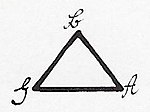Berlin Society (Erlangen)
The Berlin Society was an early student union at the Friedrich-Alexander University in Erlangen . It was created in 1796 when the Erlangen student body was reorganized.
history
In the winter semester of 1795/96, the liaison system at the Friedrich-Alexander University came to a standstill. It was decided to form four societies, which were named after the inns. Anyone who wanted to participate in student life had to join one of these societies. More than four of them should not be tolerated. The forces opposed to the student orders were brought together in the Westphalian society. Your cantonal area included not only Westphalia, but also all of northern Germany. The other two inn companies were dominated by the Black Order and the Amicist Order until 1798 .
The Westphalians had their Kommershaus in the blue bell, their North German part in the grape. This new society was called the Berliner Gesellschaft and kept the name to the end. In addition, Märkische Gesellschaft was used as a second name. The Berlin company had joined the Märkerkartel in 1798. The federal symbol was VCM = Vivat Circulus Marchiae. As in all cartel associations, the Märker circle was used as a circle . The colors were black and orange. The term Berlin Society was never suppressed. In the question of the order, which led to the founding of the Corps Onoldia in 1798 , the anti-religious Westphalians and Berliners sided with the Ansbachers. At that time the triangle sign with G (Westphalia), B (Berliner) and A (Ansbacher) was created. It was anti-religious and did not contain the Amicists. In the summer semester of 1799 there must have been arguments in the Marchia; because members resigned and switched to the Westphalia and also to the Ansbachers. With the Peace of Pressburg (1805) Erlangen was no longer a Prussian university. The influx did not come. In July 1806 there were only two Poles left, so that the Berliners had to disband on July 22, 1806. Bonawentura von Niemojowski went over to the Westphalia. His brother Gabriel probably also spent his last year with the Westphalia. As the last Berliners, the two were adopted on August 4, 1798 by the Erlangen Seniors' Convent with a Comitat to Forchheim. In Erlangen, the Brandenburg colors of black and orange went out forever.
Members
- Friedrich Karl Julius Schütz (1779–1844), philosopher
- Josias Neumann (1782–1855), legal historian in Kazan and Dorpat
- Johann Gustav Gottlieb Büsching (1783–1829), archaeologist, Germanist and folklorist
- Otto von Dewitz (1780–1864), Minister in Mecklenburg-Strelitz
- Karl Konstantin Haberle (1764–1832), botanist, meteorologist and mineralogist
- Karl Ernst von Ernsthausen (1782–1847), district administrator in Gummersbach
- Friedrich von Bärensprung (1779–1841), Lord Mayor of Berlin
- Bonawentura von Niemojowski (1787–1835), President of the Polish National Government 1830/31
literature
- Erich Röhlke: Orange - Study of the symbolic content of a Kösener Corps color . Once and Now, Yearbook of the Association for Corporate Student History Research, Vol. 14 (1969), pp. 137-148.
- Ernst Meyer-Camberg : The Berlin or Märkische Gesellschaft in Erlangen . Once and Now, Yearbook of the Association for Corps Student History Research, Vol. 25 (1980), pp. 129-140.
